Exploring the Timeless Allure of Vintage Solitaire Rings
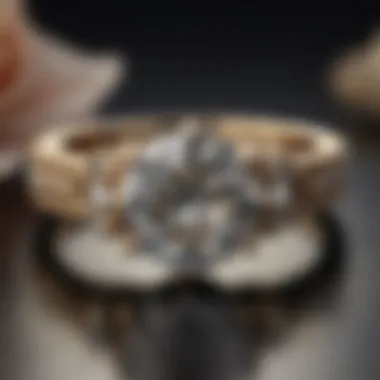
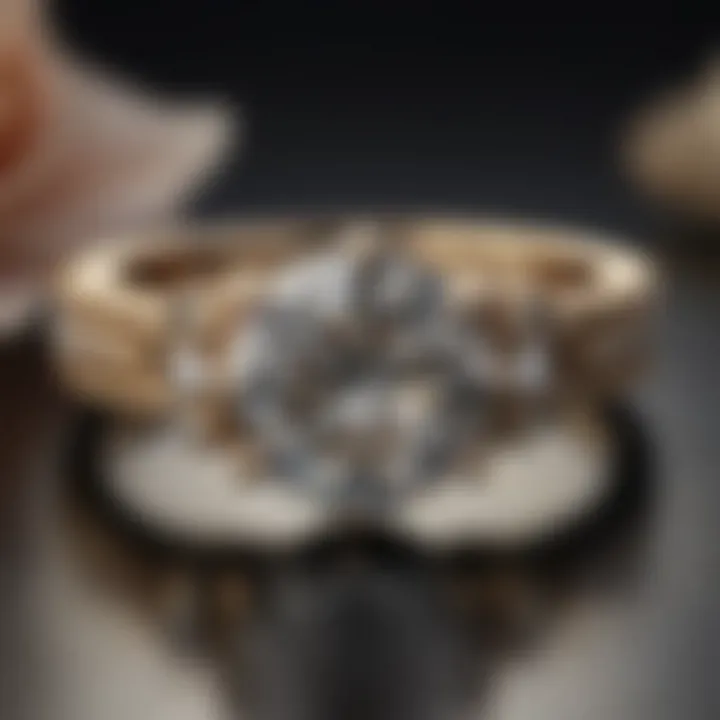
Intro
Vintage solitaire rings have fascinated jewelry enthusiasts for generations. With an allure that transcends time, these rings reflect not merely personal style but also the history and craftsmanship behind them. Each stone, setting, and design encapsulates the spirit of an era, opening a window into the past. This article endeavors to unpack that history while guiding readers through the intricate details of gemstone selection, significance, and maintenance. For collectors and aficionados alike, the quest for the perfect vintage solitaire goes far beyond just aesthetics—it embodies a connection to heritage and artistry.
Gemstone Overview
Definition and Characteristics
At the heart of every vintage solitaire ring lies the gemstone, often regarded as the beating heart of the piece. Typically defined as a single decorative stone set in a ring, a solitaire ring aims to showcase the beauty of its centerpiece clearly and unambiguously. These gemstones can range from the classic diamond to lesser-known yet equally stunning options like tourmaline or garnet.
Characteristics of these stones vary widely:
- Clarity: The internal beauty of a gemstone, or lack thereof, can significantly impact its value and desirability.
- Cut: This refers to how well the stone has been shaped and polished. A well-cut gemstone can exhibit brilliance that captivates the eye.
- Color: Each stone has its unique hue and saturation, contributing to its identity and value.
A well-chosen gemstone can dramatically elevate the overall aesthetic of a vintage solitaire ring, making understanding these characteristics crucial for any prospective buyer or collector.
Classification of Gemstones
Gemstones can generally be categorized into two primary types: precious and semi-precious. Historically, the distinction primarily came down to rarity and value, with precious stones such as diamonds and emeralds often taking the spotlight. However, semi-precious gems like amethyst or citrine have gained prominence, particularly in vintage pieces.
Notably, the classifications are:
- Precious Gemstones:
- Semi-Precious Gemstones:
- Diamond: Timeless and traditionally favored as a symbol of love.
- Ruby: Known for its intense red color, it symbolizes passion.
- Sapphire: Often associated with nobility, boasting a variety of colors, including blue, yellow, and pink.
- Emerald: Renowned for its lush green tone, symbolizing rebirth.
- Amethyst: A favorite for its rich purple hue.
- Garnet: Symbolizes loyalty, often in deep red shades.
- Citrine: Brings a warm yellow tone, often associated with success.
- Aquamarine: Breathes the tranquil blue of the sea, bringing a sense of calmness.
Understanding these classifications aids collectors in making informed decisions about vintage solitaire rings while adding dimensions of rarity, value, and timelessness to their selections.
Historical Significance
Ancient Uses and Cultural Importance
The historical significance of gemstones stretches back to ancient civilizations. In many cultures, gemstones were believed to possess mystical properties. For instance, ancient Egyptians adorned tombs with lapis lazuli to ensure safe passage to the afterlife. Similarly, the Greeks viewed certain stones as symbols of power and protection.
- Indian Culture: In Hindus, rubies and diamonds are respected as symbols of divine power.
- Ancient Rome: The Romans believed that specific stones would grant them strength in battle.
Notably, certain gemstones have carved out specific niches in various cultures, enhancing their significance throughout the ages.
Myths and Legends Surrounding Gemstones
Each gemstone often carries folklore and myths that enhance its allure. Take diamonds for example; they are frequently linked with eternal love and commitment. The emerald, with its striking color, is said to bring balance and harmony to life.
"Myths give gemstones personality. They offer a history that goes beyond nature's beauty."
Understanding these stories not only enriches the gemstone but also elevates the emotional connection one might have with the piece.
In summary, the journey through vintage solitaire rings is not just about the modern aesthetics; it is a venture into the depths of history, validating the rings' enduring attraction in today’s market.
Foreword to Vintage Solitaire Rings
Vintage solitaire rings hold an essential place in the realm of fine jewelry, captivating the hearts of gemstone enthusiasts and collectors alike. These rings not only symbolize love and commitment but also embody a rich tapestry of history and artistry that spans generations. Unlike their modern counterparts, vintage solitaire rings boast unique characteristics that can tell stories of the past, diving deep into cultural significances and evolutionary design trends.
Understanding the allure of vintage solitaire rings involves appreciating several key elements. First and foremost, their historical context provides insight into the craftsmanship and artistry of different eras. Each piece is a reflection of its time, whether it originates from the Art Deco period with its geometric elegance or from the Victorian age, which celebrated intricate details and romanticism.
In this article, we will explore numerous facets that contribute to the beauty and desirability of vintage solitaire rings. The craftsmanship behind these rings is truly remarkable. Artisan techniques have evolved yet retained their essence, showcasing skilled handwork that mass-produced items cannot replicate. Furthermore, the choice of gemstones, whether it be a brilliant diamond or a vibrant ruby, lends each ring its individual charm and value.
Additionally, we will examine how these rings are often seen as wise investments. With the fluctuations in market trends, buyers become increasingly discerning, recognizing the significance of quality gemstones and the rarity of truly vintage pieces. This brings about a consideration that transcends simply aesthetics; it's about valuing history, artistry, and the stories these rings encapsulate.
Vintage solitaire rings are not mere accessories; they are tokens of love steeped in history, each with a story waiting to be unearthed.
As we navigate through this exploration, we will address practical aspects that enthusiasts, collectors, and even jewelry designers should consider. From identifying authenticity to caring for these delicate treasures, understanding the nuances of vintage solitaire rings can greatly enhance one's appreciation and investment potential. In essence, this article seeks to offer a comprehensive guide that makes the intricacies of vintage solitaire rings accessible and engaging, ensuring readers are well-equipped to appreciate these timeless symbols.
Historical Context of Solitaire Rings
Understanding the historical context of solitaire rings provides depth to their significance in the jewelry world. These rings are not just beautiful adornments; they carry stories and cultural symbols that have evolved through time. By tracing the origins and developments of solitaire rings, we not only appreciate their aesthetic appeal but also recognize the craftsmanship and historical markers that inform their value today.
The Origins of Solitaire Rings
The inception of solitaire rings dates back to ancient civilizations, where they initially served not just as jewelry but as tokens of commitment and status. The very first examples can be traced to Ancient Egypt, where gold rings were often inscribed with hieroglyphs and symbolized eternity and love.
Later on, in the Middle Ages, we find records of betrothal rings, but it was during the Renaissance that the solitaire design began to resemble what we recognize today. Jewelers began to emphasize a singular gemstone, primarily diamonds, set in simply ornate bands, signifying unmatched devotion.
Evolution Through the Decades
As time rolled on, solitaire rings underwent significant transformations, mirroring changing tastes and societal norms. In the Victorian era, rings often featured intricate designs, with meaningful motifs encircling the gemstone. The following Edwardian period heralded a shift towards intricate filigree work, often influencing the aesthetics of solitaire rings.
By the mid-20th century, particularly the 1950s, diamonds became synonymous with engagement, establishing the classic diamond solitaire as the ultimate expression of love. Jewelers like Tiffany & Co. started popularizing the six-prong setting, ensuring that the diamond captured maximum light, enhancing its brilliance—this technique remains highly sought after today.
Cultural Significance
Across various cultures, solitaire rings symbolize more than just personal expression. For instance, in Eastern cultures, particular gemstones are considered to carry specific meanings and are deeply intertwined with beliefs of luck and prosperity. In Western societies, the tradition of gifting a solitaire ring for engagements remains strong, often tied to the idea of an unbroken bond, much like the circle of the ring itself. Supporting this notion, studies show that a majority of couples still lean towards solitaire settings, hoping to convey a sense of elegance and timelessness in their promises to each other.
"In every culture, jewelry speaks a universal language of love, commitment, and historical significance, with solitaire rings acting as a central character in this narrative."
Understanding these origins helps enthusiasts and collectors to appreciate the nuances and the craftsmanship that went into each ring. From symbolism to materials used, the historical context enriches not only the significance of vintage solitaire rings but also informs their sourcing and value in today’s market.
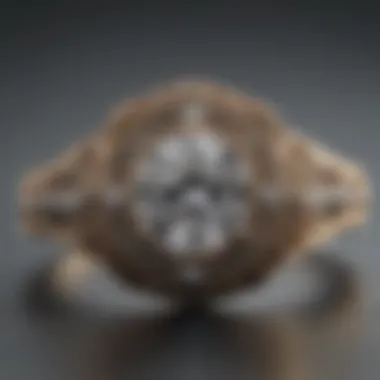
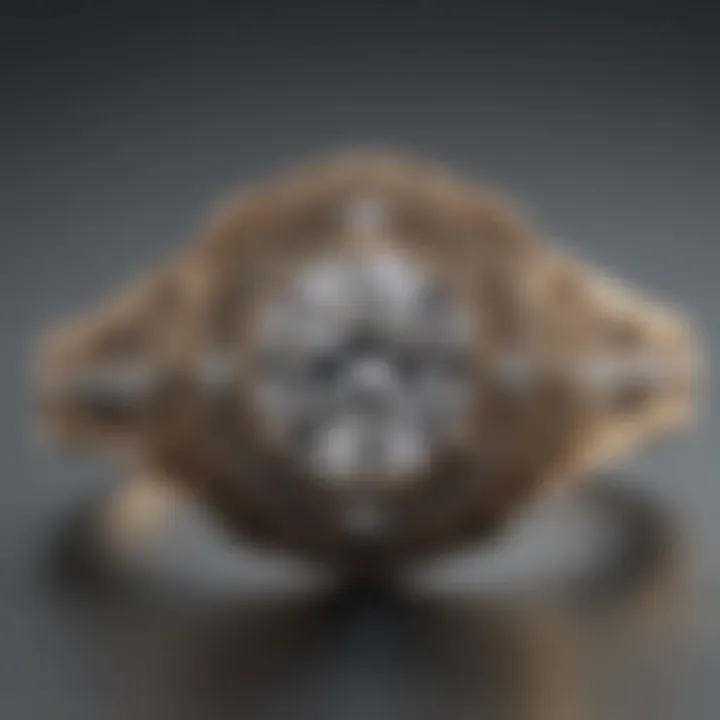
Key Design Features
When it comes to vintage solitaire rings, the design features are more than just aesthetic choices; they carry stories, traditions, and craftsmanship that reflect the era they were created in. Understanding these key design features is essential for collectors and enthusiasts alike, as they can influence the ring's beauty and value significantly. Key elements such as setting types, band styles, and overall craftsmanship play a crucial role in the allure of these rings, making them not just jewelry pieces but also significant artifacts.
Classic Settings
Classic settings are the bedrock of vintage solitaire rings. They determine how the gemstone is showcased, which can greatly affect the ring's overall look and style. Each type of setting has its unique characteristics, strengths, and weaknesses that cater to different tastes and preferences.
Prong Settings
Prong settings are perhaps the most widely recognized. This style involves small metal claws that hold the gemstone in place, allowing for maximum exposure to light. The primary characteristic of prong settings is their ability to enhance the stone's brilliance. This makes prong settings a favored choice among those who want their diamond to dazzle.
One advantage of prong settings is their versatility—they can accommodate various shapes and sizes of gemstones, offering a customizable experience. However, one must be cautious, as the prongs can be prone to snagging on clothing or other items. Regular checks are necessary to ensure that the stone stays secure and is not at risk of falling out.
Bezel Settings
Contrasting with prong settings, bezel settings encircle the gemstone completely with a metal rim, offering a more modern appeal. The strength of this setting lies in its protection of the stone. The bezel's design minimizes the likelihood of damage, making it a fantastic choice for everyday wear.
With a sleek and contemporary look, bezel settings are sought after for their elegant simplicity. They can sometimes make the gemstone appear smaller than it is, which might deter those wanting to maximize visual impact. Still, the security and low-maintenance qualities are significant merits for many collectors.
Snap Settings
Snap settings are somewhat of a rarity in the world of vintage rings but deserve attention for their unique qualities. In this type, the gemstone is snuggly fit into a case that ‘snaps’ shut around it. This offers an extremely low profile, making it less likely for the stone to get damaged.
The key characteristic of snap settings is their ability to create a seamless appearance, which enhances the vintage look. However, one must consider that not every jeweler can easily repair or replace stones set in this manner, potentially making future maintenance a bit tricky. Still, their uniqueness appeals to those looking to stand out from more common styles.
Unique Band Styles
When it comes to band styles, they are not just functional; they absolutely contribute to the vintage aesthetic that many collectors find irresistible. Here are some key styles to explore:
Split Shank
Split shank bands have a distinctive feature where the band splits into two or more strands at some point. This design elevates the ring's overall structure and often provides an illusion of a larger center stone. The split shank is an excellent option for individuals who value intricate design and a bit of drama in their jewelry.
As a unique choice, the split shank can balance out the center stone beautifully, drawing the eye upward without overwhelming it. The downside is that they can sometimes be less comfortable for everyday wear due to their width.
Eternity Bands
Eternity bands feature continuous gemstones or patterns all the way around, symbolizing everlasting love. While often associated with wedding or anniversary settings, they can also serve as striking solitaire rings.
The benefit of an eternity band lies in its uniformity and the sheer brilliance it offers, as the stones catch light from every angle. One drawback, however, can be size adjustments. Resizing an eternity band is complicated and may disrupt the design.
Vintage Inspired Designs
Vintage inspired designs are quite popular as they capture the essence of classic styles but with modern techniques. These rings often feature intricate detailing, such as engraving or filigree, making them more than just a piece of jewelry but a work of art.
Their charm comes from the stories they seem to tell, reflecting various historical influences. While they can evoke a strong sentimental vibe, there's a risk of encountering imitations, so authenticity is key in this selection. Overall, vintage inspired rings are ideal for those who admire the past but still seek a contemporary flair.
"The allure of vintage solitaire rings lies not just in the stones themselves, but in the craftsmanship and stories woven into their designs."
Carefully considering these features allows collectors to appreciate each ring's distinct history and purpose, ensuring every piece tells its own unique tale.
Popular Gemstone Choices
When it comes to vintage solitaire rings, the choice of gemstone isn't just a matter of aesthetics; it's about history, symbolism, and personal expression. Different gemstones hold unique meanings and stories, and they encapsulate the essence of the eras they come from. The significance of popular gemstone choices in vintage solitaire rings deeply enhances our understanding of these cherished pieces.
In this article, we’ll examine two main categories of gemstones: diamonds and colored gemstones, providing insight into their remarkable characteristics and the role they play in the allure of vintage solitaire rings.
Diamonds
Diamonds, often viewed as the quintessential gemstone for engagement rings, have long been associated with love and commitment. Their durability and brilliance make them a popular choice for vintage solitaire styles.
Cut Quality and Grading
When it comes to diamonds, cut quality and grading are critical steps in determining a diamond's overall beauty and value. Cut quality refers to how well a diamond has been shaped and polished, which affects its sparkle and brilliance. Grading often uses the Gemological Institute of America's criteria, which considers factors like proportions, symmetry, and polish.
A well-cut diamond reflects light beautifully, making it a sought-after choice in vintage settings. The unique feature of cut quality is that it can highlight the clarity and color of the stone, adding depth and vibrancy. However, a lower cut grade can result in a dull appearance, diminishing its overall appeal. Thus, understanding cut quality is essential for anyone looking to invest in or appreciate a vintage diamond solitaire.
Color and Clarity
Moving on to color and clarity, these are significant factors that contribute to a diamond's allure. When one thinks of diamond color, it's typically about the absence of color. Diamonds are graded on a scale where "D" is colorless and less desirable hues range down the alphabet. Clarity, on the other hand, refers to the presence of internal or external flaws in the stone, known as inclusions.
High clarity diamonds are prized because they display a breathtaking sparkle and catch the eye better. However, many vintage lovers often appreciate stones with minor inclusions, as they can add character and authenticity to the piece. Additionally, a faint hint of color can provide a vintage diamond with charm that collectors often find appealing.
Historical Cuts in Vintage Rings
Historical cuts in vintage diamond rings are particularly interesting. As styles evolved over time, so did the techniques used to shape and polish diamonds. For example, the old mine cut and cushion cut were dominant in the Victorian era, showcasing a more romantic style than the modern round brilliant cut.
These historical cuts often come with unique characteristics, such as a deeper pavilion that gives a more organic form. Vintage ring enthusiasts appreciate these distinct cuts because they bring history to life, serving as a window into the past. However, sourcing these cuts can be challenging. They often come with emotional stories that resonate with buyers, making them a rewarding find.
Colored Gemstones
While diamonds are often the star in vintage solitaire rings, colored gemstones have their unique place too. They provide a burst of color, allowing for personalization and distinctiveness. This section will delve into a few of the most popular colored gemstone choices: sapphires, emeralds, and rubies.
Sapphires
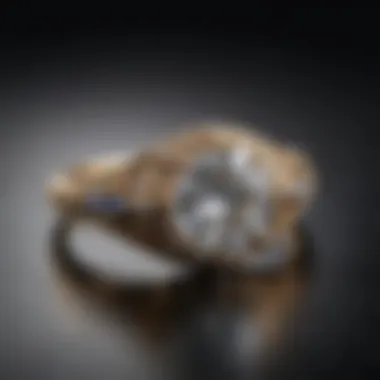
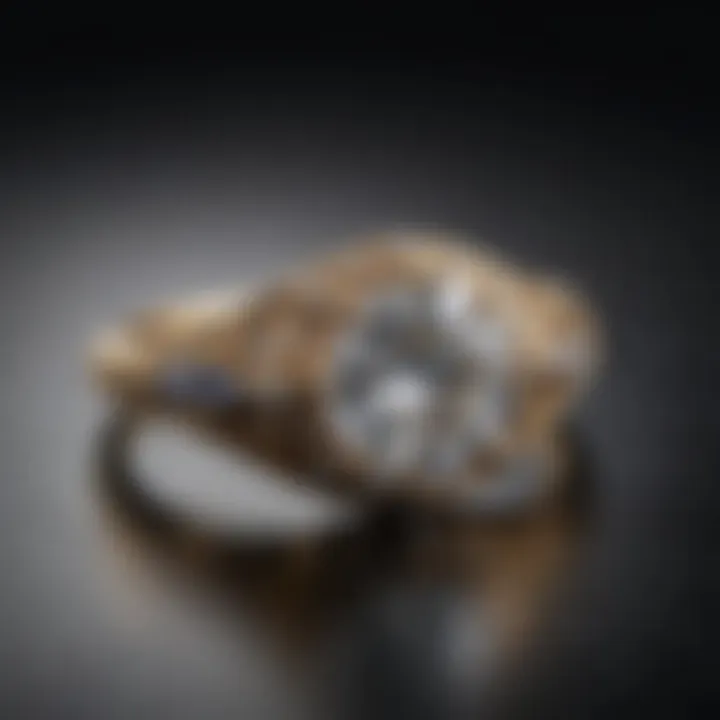
Sapphires are revered for their vivid blue color, though they come in a rainbow of shades. The royal blue color is particularly iconic, and it symbolizes loyalty and nobility. This gemstone's durability makes it an excellent choice for everyday wear, which is why many vintage pieces feature sapphires set in elegant styles.
The unique characteristic is that sapphires can be sourced in different hues, catering to diverse aesthetics. A stunning sapphire ring can often be a conversation starter due to its eye-catching color. The disadvantage is that they can be more challenging to find in specific shades, limiting options for collectors.
Emeralds
Emeralds are lustrous green gemstones, symbolizing rebirth and fertility. They are unique for their fascinating inclusions, which are often seen as "nature's fingerprints". This quality makes every emerald unique, and many collectors celebrate these inclusions as a part of the gem's charm.
Emeralds, however, require extra caution. They are softer than diamonds and can chip easily if not cared for. This characteristic limits their practicality for some wearers, but the allure of a vintage emerald ring often outweighs these concerns for dedicated aficionados.
Rubies
Rubies are gemstones steeped in history, often associated with passion and protection. Their deep crimson hue evokes emotions and is striking against many metal settings. Vintage ruby rings truly stand out because of their rich color, making them highly popular among collectors.
The unique feature of rubies is that the best quality are known as "pigeon's blood" rubies, sourced from Myanmar. These are coveted for their vibrant color and sheen, and while they can be expensive, true vintage rubies are often more accessible in alternative settings. However, similar to emeralds, rubies require careful handling to maintain their integrity.
In summary, the choice of gemstones in vintage solitaire rings significantly enhances their story and connection to the past. Diamonds bring timeless elegance, whereas colored gemstones showcase individual personality and uniqueness.
The Role of Craftsmanship
Craftsmanship is the backbone of vintage solitaire rings. It speaks volumes about the dedication and skill of artisans who have shaped each piece with care. When we look closer at these rings, we don’t just see metal and stone; we witness the result of hours, if not days, of labor, artistry, and meticulous attention to detail. This dedication to craft has ensured that many of these rings have endured through the ages, maintaining their charm and beauty for modern admirers.
Every aspect of craftsmanship contributes to the overall aesthetic and integrity of the ring. From the techniques used to create intricate designs to the choice of materials, craftsmanship lays the foundation on which the value of these pieces rests. Understanding the nuances of artisan techniques not only helps collectors appreciate the artistry behind these gems, but also allows them to make informed decisions when purchasing or maintaining vintage solitaire rings.
Artisan Techniques
Hand Engraving
Hand engraving is one of the most revered techniques in jewelry making. This method involves an artisan manually carving intricate designs or patterns into the metal of the ring. The result is a unique and personal touch that machine-made pieces simply can't replicate.
One key characteristic of hand engraving is its ability to highlight the craftsmanship involved in each piece. People often gravitate towards these rings because they tell a story — the engraver's skill shines through in the delicate curlicues and sweeping lines. A ring with such engravings develops character over time, often referred to as "patina," giving it even more charm. However, it’s worth noting that hand-engraved pieces require careful handling to protect the intricate details from wear and tear.
Filigree Work
Filigree work is truly an art form. This technique involves twisting fine threads of metal into delicate patterns that can enhance the beauty of any ring. The process resembles lace, and this detailed work showcases the artisan's care and attention to the smallest details.
The standout feature of filigree is its lightness and ethereality. When executed well, it can transform a simple solitaire ring into a breathtaking piece that draws eyes. It's a popular choice in vintage rings precisely because it adds a sense of delicacy and intricacy. However, due to the fine nature of the work, filigree can be more susceptible to damage if not stored or cared for properly.
Quality of Metals
When discussing the quality of metals, it’s essential to understand how it plays a role in the ring's longevity and overall aesthetic appeal. Vintage solitaire rings often utilize high-quality materials such as platinum, 18k gold, or even unique alloys that may not be commonly produced today.
One key aspect of quality metals is their inherent durability. A ring made from high-quality gold or platinum maintains its brilliance and resists wear over the years. Investing in a piece crafted from superior metals not only enhances its beauty but also ensures that it will withstand daily wear, making it a worthwhile addition to any collection. On the other hand, lower-quality metals might tarnish or lose their shine over time, which can be a significant drawback for collectors looking for lasting beauty.
Notable Jewelers and Houses
Historical Influencers
Historical influences in jewelry design have left an indelible mark on vintage solitaire rings. Many renowned jewelers from the past set trends that are still admired and emulated today. Their unique styles and techniques often reflected societal influences, showcasing how jewelry could signify status or personal expression.
These historical figures often had signature elements or design philosophies that continue to guide modern artisans. Their contributions not only shaped the market but also established a standard for quality and innovation. Collectors often seek out pieces from these iconic periods, as they can be seen as not just personal adornments but also investments in art history.
Modern Artisans
In the realm of vintage solitaire rings, modern artisans play a pivotal role in keeping the spirit of craftsmanship alive. While they often draw inspiration from historical designs, they also incorporate contemporary styles and techniques to create pieces that resonate with today’s collectors.
The key characteristic of modern artisans is their ability to blend traditional methods with innovative approaches. This harmonious blend results in rings that maintain the charm of vintage pieces while appealing to modern sensibilities. However, collectors may need to verify the authenticity and craftsmanship of these pieces, as the market can sometimes be flooded with imitations that lack true artisanal quality.
The combination of historical craftsmanship and modern techniques is reshaping the landscape of vintage solitaire rings, making them accessible and relevant to new generations of collectors.
Identifying Authentic Vintage Solitaire Rings
When it comes to vintage solitaire rings, knowing how to identify authentic pieces cannot be overstated. There’s an undeniable allure that surrounds these designs, often steeped in rich history and sentimental value. Understanding the traits that set genuine rings apart from less authentic or even replica versions is crucial for collectors and enthusiasts alike. This section will dissect some essential indicators of authenticity, providing clarity to those eager to ensure their investment is both genuine and valuable.
Key Indicators of Authenticity
Hallmarks and Stamps
Hallmarks and stamps serve as the first line of defense when it comes to identifying real vintage solitaire rings. These small engravings, often found inside the band, denote the metal's purity and can sometimes indicate the jeweler’s mark. The key characteristic of these markings is that they are deeply ingrained; they tend not to wear away easily over time, making them a reliable source of information.
Why consider them? Well, hallmarks validate the authenticity of your piece, revealing its age and ensuring it complies with legal standards of metal quality.
Unique features of hallmarks include:
- Symbolic Codes: They often incorporate symbols or letters, revealing more about the ring's origin.
- Geographic Markings: Certain symbols indicate the country of origin, which is particularly helpful in gauging the ring's history.
The disadvantage is that some less reputable dealers might get creative with these marks, so always do thorough research before making a purchase.
Patina and Wear
Patina and wear play a significant role in identifying authentic vintage items. Over the years, natural oxidation processes give metals a unique surface texture, often characterized by a warm, soft glow.
The key characteristic here is the balance between wear that denotes age and the structural integrity which needs to be maintained. A well-loved vintage ring should show signs of life, capturing its history while still remaining functional.

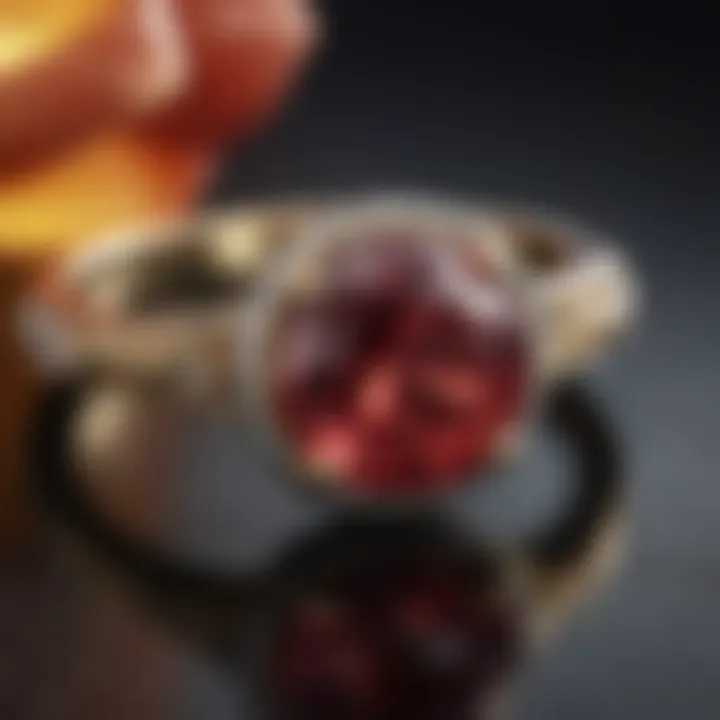
In vintage jewelry, having some signs of wear can actually boost desirability among collectors, as it showcases the ring’s journey.
Unique features include:
- Natural Color Changes: Unlike shiny new rings, an authentic piece will often have a deeper, richer hue.
- Original Textures: Hand-finished techniques from artisans of the past can leave behind unique textures absent in modern pieces.
However, over-polishing can strip away this history, so always approach cleaning with care.
Documentation and Provenance
Documentation and provenance act as detailed narratives that accompany any genuine vintage solitaire ring. Provenance refers to the history of ownership while documentation can include anything from receipts to original design blueprints.
The key characteristic of strong documentation is consistency and clarity. An authentic piece usually comes with a traceable history that can showcase its origins proudly and add to its value.
Unique features include:
- Certificates of Authenticity: These offer verification from reputable appraisers, giving you peace of mind over your purchase.
- Previous Ownership: Knowing the previous owners or their context can elevate the ring’s narrative.
On the flip side, not every antique piece will have complete documentation, so some discretion is required when evaluating a ring.
In the realm of vintage jewelry, the journey of each piece is intimately tied to its identity—finding that out is part of the magic.
Caring for Vintage Jewelry
Proper care for vintage jewelry, particularly vintage solitaire rings, is crucial for maintaining their beauty and integrity. These pieces often carry not just aesthetic value but also historical significance. After all, they have witnessed the passage of time, holding memories and stories that enhance their allure. Therefore, understanding how to care for these gems is essential for both their longevity and their sentimental worth.
Cleaning and Maintenance
Keeping vintage solitaire rings clean requires a gentle touch. Regular maintenance can prevent the buildup of dirt and oils that dull the stone's sparkle. Here are some key practices to consider:
- Use mild soap and water: A soft cloth or a gentle brush dipped in warm, soapy water can work wonders. Avoid harsh chemicals as they can damage both the metal and the gemstones.
- Dry thoroughly: After cleaning, make sure the ring is completely dry. Moisture can lead to tarnishing and other issues over time.
- Storing properly: When not wearing your ring, store it in a soft-lined jewelry box or pouch to prevent scratches. Avoid tossing it into a drawer with other jewelry to reduce the risk of damage.
Taking these steps not only helps maintain the ring’s shine but also preserves its structural integrity.
Professional Restoration
Over time, even the best-taken-care-of vintage rings will show signs of wear. Professionals specializing in jewelry restoration can restore both beauty and functionality to these beloved pieces. Here’s why consulting a professional is often the best course of action:
- Expert knowledge: Jewelers with experience in vintage pieces understand the materials, craftsmanship, and potential risks associated with restoration. They can advise on what can and cannot be done without compromising the piece.
- Authenticity retention: A skilled restorer can preserve the authenticity of the ring while carrying out necessary repairs. This is crucial for collectors, as alterations can affect both sentimental and market value.
- Complex repairs: Some issues, like resetting a loose stone or repairing a damaged band, require specialized tools and skills that only a professional can provide.
Preserving the integrity of vintage jewelry enhances its timeless appeal and value, making it essential for collectors and enthusiasts alike.
By following the described preservation methods, one not only protects the physical aspect of these rings but also honors their rich history.
Investment Potential of Vintage Solitaire Rings
When one thinks about vintage solitaire rings, the first thoughts that may come to mind involve their beauty and craftsmanship. However, there's another dimension worth exploring—their investment potential. As with any fine jewelry, vintage solitaire rings can serve not only as adornments but also as financial assets. Collectors and enthusiasts alike should consider a few facets before diving into this alluring market.
The significant allure of vintage solitaire rings lies in their historical context and unique craftsmanship. Unlike modern mass-produced pieces, vintage rings carry a sense of story and individuality, factors that can dramatically influence their market value.
Market Trends
In recent years, the market for vintage jewelry has surged. People are increasingly drawn to sustainable luxury options, and vintage pieces fit that bill perfectly. The current trend aligns well with desires for uniqueness, sustainability, and a deeper connection with the past.
Interest from younger generations is reshaping the landscape, as millennials and Gen Z individuals prioritize personalized designs over standard offerings. Online platforms, auctions, and social media serve as catalysts in this vibrant marketplace. Moreover, the combination of nostalgia and investment is enticing individuals to revisit what's old and make it new again. This phenomenon isn't purely functional—it has emotional roots as well.
Valuation Factors
Gemstone Quality
When talking about gemstone quality, it’s essential to highlight that vintage rings often feature stones of exceptional craftsmanship. The cut and clarity not only affect visual appeal but also influence the ring's investment worth. Many vintage solitaire rings flaunt unique cuts that aren't commonly found in modern jewelry. This rarity enhances their desirability.
High-quality gemstones, especially when graded correctly, can command premium prices. However, buyers must be cautious; assessing a gemstone's quality without proper knowledge can lead to poor purchases.
Rarity
Rarity is another essential factor in determining investment potential. Vintage solitaire rings that are scarce or represent a specific period in jewelry making often fetch higher prices. For instance, Victorian rings with unique settings or Art Deco pieces with geometric designs may catch the eye of collectors looking for specific styles or historical significance.
A rare piece not only adorns the wearer’s hand, but can also act like a hidden treasure, ready to appreciate over time. However, keep in mind that rarity also drives up prices—so affordability may wane for truly unique finds.
Historical Value
Historical value ties in closely with both rarity and the overall narrative behind a piece. Vintage solitaire rings that have been linked to significant events or figures can draw substantial attention from collectors. Such stories elevate them beyond mere jewelry, making them artifacts from a particular time or culture.
A piece with historical value might not only look stunning on your finger but could also serve as a conversation starter about its history. However, verifying provenance can be challenging, potentially making some buyers hesitant to invest blindly.
"In the intricate world of vintage jewelry, beauty and investment intertwine, making each piece a blend of artistry and potential value."
In essence, while vintage solitaire rings are celebrated for their undeniable beauty, a discerning collector can also view them as valuable investments. Understanding market trends, valuation factors like gemstone quality, rarity, and historical significance are crucial in making informed choices. It isn't merely about owning a piece of jewelry; it's about investing in a tangible connection to history and artistry.
Ending
In summarizing the rich tapestry woven through the history and craftsmanship of vintage solitaire rings, it becomes evident that these timeless pieces hold more than just aesthetic value; they embody stories of emotion, evolution, and artistry. Vintage solitaire rings represent a fusion of past craftsmanship, material choices, and emblematic artistry that resonates with both collectors and enthusiasts today.
The nuanced understanding of these rings, as illuminated throughout this article, extends beyond mere appreciation. When delving into the market potential, one finds an ever-fluctuating landscape dictated by changing tastes, economic conditions, and cultural significance. Understanding the investment potential involves considering a range of factors—quality of gemstones, rarity of design, and the historical context that gives rise to each unique piece.
Moreover, the caring and maintenance of vintage jewelry ensure that these artifacts remain in pristine condition, serving as a poignant reminder of the craftsmanship of yesteryears. Practicing proper care not only enhances their beauty but also maintains their value over time.
The research into identifying authentic vintage rings further enhances a collector's ability to make informed purchases, ensuring that every acquisition is both meaningful and well-grounded in reality. In a world often focused on the fashionable and the new, vintage solitaire rings serve as a timeless reminder of the enduring appeal of the past, making each piece a treasure that connects wearers to history, emotion, and artistry.
Vintage solitaire rings are more than just ornaments; they are fragments of history, echoing stories of love, commitment, and artistry that transcends generations.
As we finish this exploration, it’s clear that delving into the realm of vintage solitaire rings enriches not only one’s knowledge but also enhances the appreciation for this exquisite category of fine jewelry. Whether you’re a novice or a seasoned collector, the insights gained can guide you in making informed decisions when selecting these extraordinary pieces.







